The Effects of Pollution on Human Health: A Comprehensive Analysis
VerifiedAdded on 2023/01/11
|8
|2765
|54
Report
AI Summary
This report investigates the multifaceted impact of pollution on human health. It begins by defining pollution and outlining various types, including air, water, and soil pollution, and their respective causes, such as industrialization, agricultural practices, and waste disposal. The report then delves into the detrimental effects of pollution on human health, detailing respiratory diseases, cardiovascular damage, skin allergies, and other ailments. It also explores the economic burden associated with treating pollution-related illnesses. The literature review examines the causes of pollution, including industrial emissions, agricultural runoff, and improper waste management. Furthermore, the report analyzes the impact of pollution on human health, including diseases and climate change impacts. The research methodology section explains the use of qualitative and quantitative methods, as well as primary and secondary data sources. The findings highlight the critical need for pollution control and the importance of sustainable practices. The report concludes with recommendations for reducing pollution and improving human health, emphasizing the roles of individuals, corporations, and governments in implementing effective strategies. The report underscores the urgency of addressing pollution to enhance the quality of life and protect the environment.
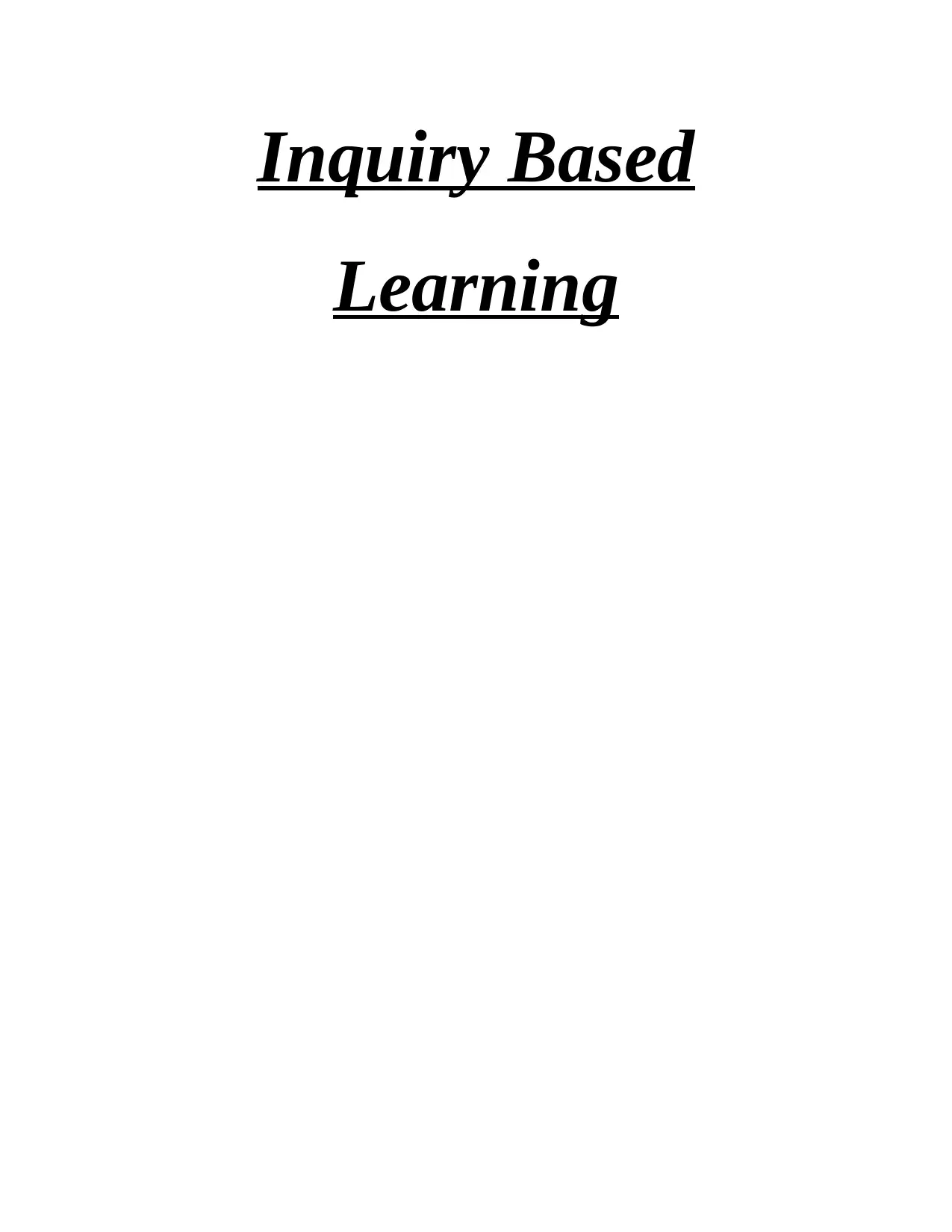
Inquiry Based
Learning
Learning
Paraphrase This Document
Need a fresh take? Get an instant paraphrase of this document with our AI Paraphraser
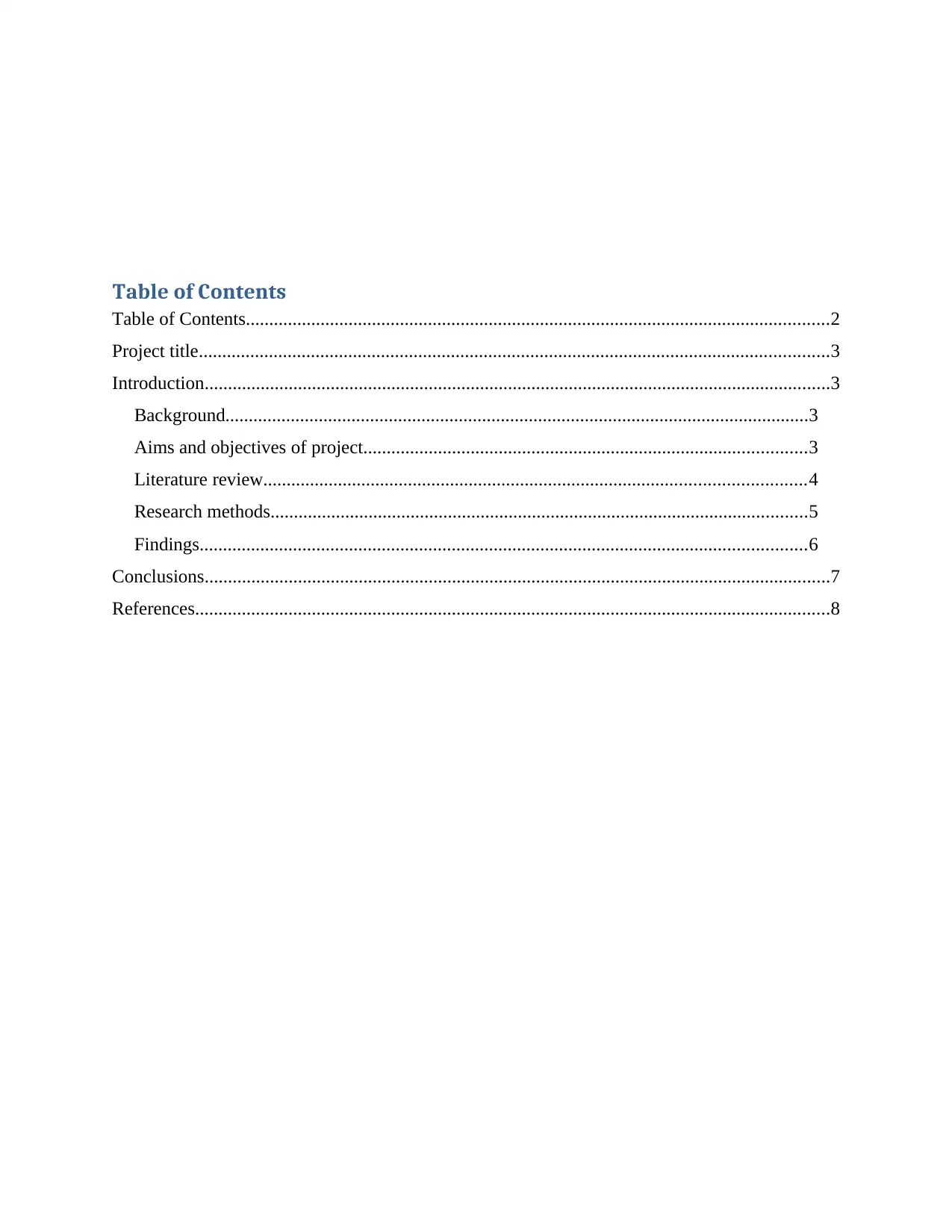
Table of Contents
Table of Contents.............................................................................................................................2
Project title.......................................................................................................................................3
Introduction......................................................................................................................................3
Background.............................................................................................................................3
Aims and objectives of project...............................................................................................3
Literature review....................................................................................................................4
Research methods...................................................................................................................5
Findings..................................................................................................................................6
Conclusions......................................................................................................................................7
References........................................................................................................................................8
Table of Contents.............................................................................................................................2
Project title.......................................................................................................................................3
Introduction......................................................................................................................................3
Background.............................................................................................................................3
Aims and objectives of project...............................................................................................3
Literature review....................................................................................................................4
Research methods...................................................................................................................5
Findings..................................................................................................................................6
Conclusions......................................................................................................................................7
References........................................................................................................................................8
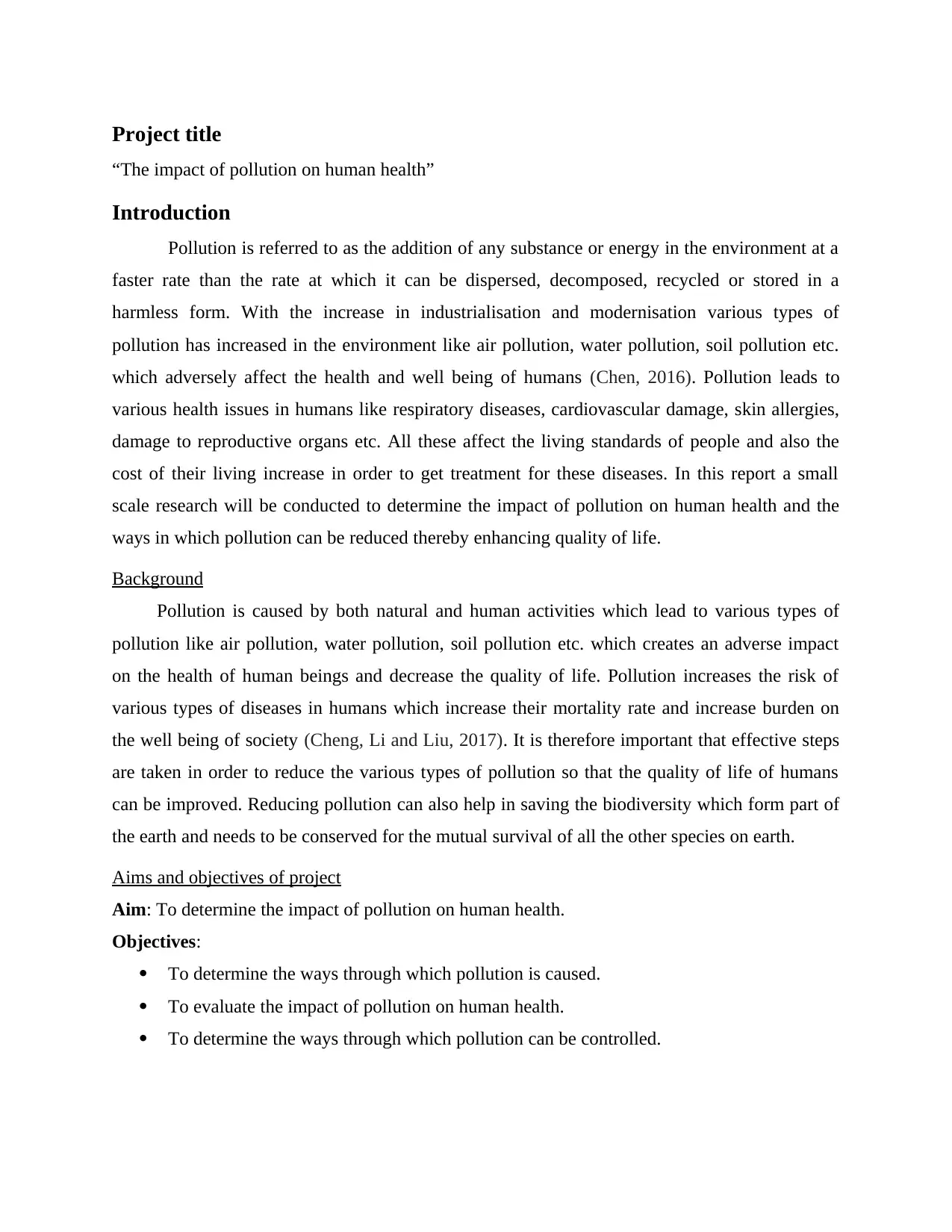
Project title
“The impact of pollution on human health”
Introduction
Pollution is referred to as the addition of any substance or energy in the environment at a
faster rate than the rate at which it can be dispersed, decomposed, recycled or stored in a
harmless form. With the increase in industrialisation and modernisation various types of
pollution has increased in the environment like air pollution, water pollution, soil pollution etc.
which adversely affect the health and well being of humans (Chen, 2016). Pollution leads to
various health issues in humans like respiratory diseases, cardiovascular damage, skin allergies,
damage to reproductive organs etc. All these affect the living standards of people and also the
cost of their living increase in order to get treatment for these diseases. In this report a small
scale research will be conducted to determine the impact of pollution on human health and the
ways in which pollution can be reduced thereby enhancing quality of life.
Background
Pollution is caused by both natural and human activities which lead to various types of
pollution like air pollution, water pollution, soil pollution etc. which creates an adverse impact
on the health of human beings and decrease the quality of life. Pollution increases the risk of
various types of diseases in humans which increase their mortality rate and increase burden on
the well being of society (Cheng, Li and Liu, 2017). It is therefore important that effective steps
are taken in order to reduce the various types of pollution so that the quality of life of humans
can be improved. Reducing pollution can also help in saving the biodiversity which form part of
the earth and needs to be conserved for the mutual survival of all the other species on earth.
Aims and objectives of project
Aim: To determine the impact of pollution on human health.
Objectives:
To determine the ways through which pollution is caused.
To evaluate the impact of pollution on human health.
To determine the ways through which pollution can be controlled.
“The impact of pollution on human health”
Introduction
Pollution is referred to as the addition of any substance or energy in the environment at a
faster rate than the rate at which it can be dispersed, decomposed, recycled or stored in a
harmless form. With the increase in industrialisation and modernisation various types of
pollution has increased in the environment like air pollution, water pollution, soil pollution etc.
which adversely affect the health and well being of humans (Chen, 2016). Pollution leads to
various health issues in humans like respiratory diseases, cardiovascular damage, skin allergies,
damage to reproductive organs etc. All these affect the living standards of people and also the
cost of their living increase in order to get treatment for these diseases. In this report a small
scale research will be conducted to determine the impact of pollution on human health and the
ways in which pollution can be reduced thereby enhancing quality of life.
Background
Pollution is caused by both natural and human activities which lead to various types of
pollution like air pollution, water pollution, soil pollution etc. which creates an adverse impact
on the health of human beings and decrease the quality of life. Pollution increases the risk of
various types of diseases in humans which increase their mortality rate and increase burden on
the well being of society (Cheng, Li and Liu, 2017). It is therefore important that effective steps
are taken in order to reduce the various types of pollution so that the quality of life of humans
can be improved. Reducing pollution can also help in saving the biodiversity which form part of
the earth and needs to be conserved for the mutual survival of all the other species on earth.
Aims and objectives of project
Aim: To determine the impact of pollution on human health.
Objectives:
To determine the ways through which pollution is caused.
To evaluate the impact of pollution on human health.
To determine the ways through which pollution can be controlled.
⊘ This is a preview!⊘
Do you want full access?
Subscribe today to unlock all pages.

Trusted by 1+ million students worldwide
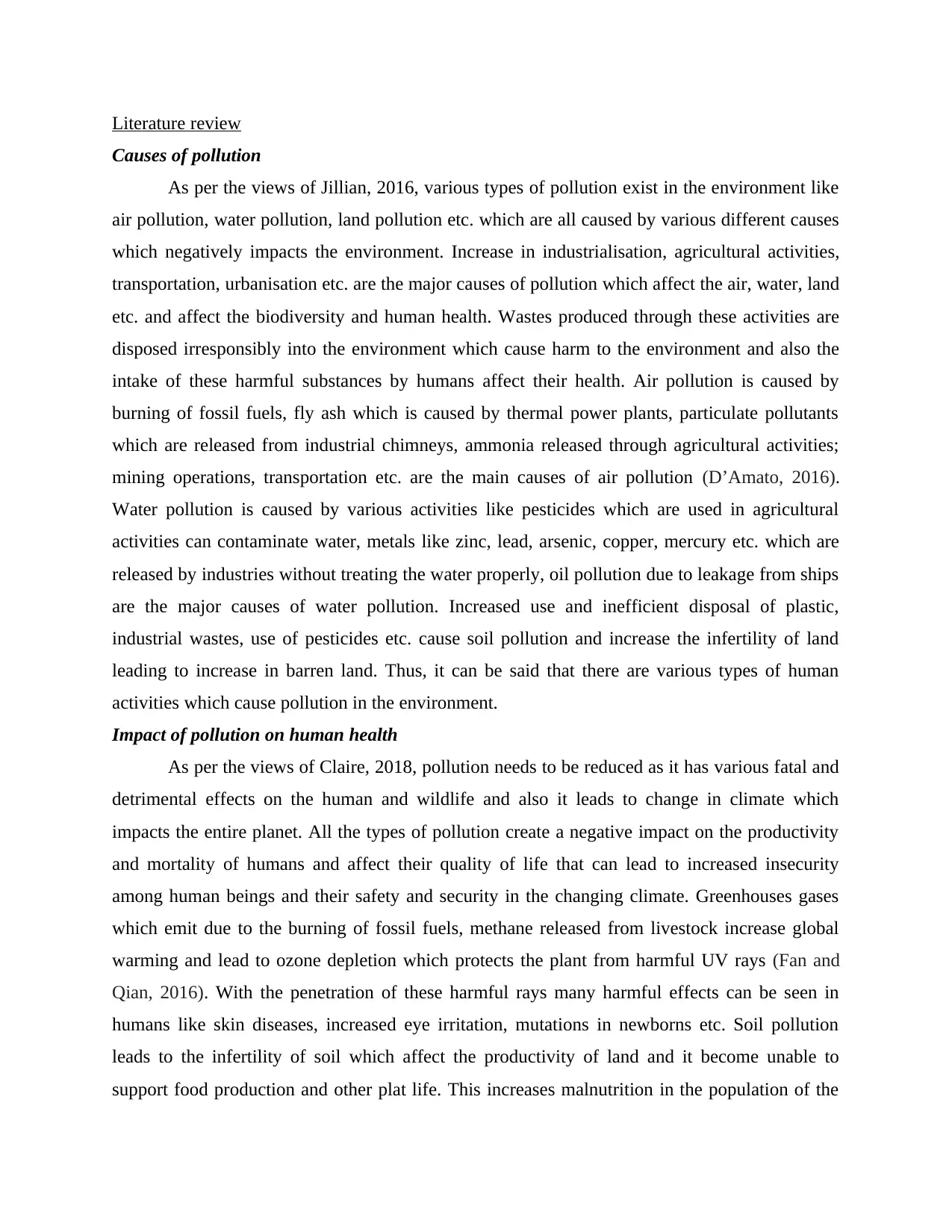
Literature review
Causes of pollution
As per the views of Jillian, 2016, various types of pollution exist in the environment like
air pollution, water pollution, land pollution etc. which are all caused by various different causes
which negatively impacts the environment. Increase in industrialisation, agricultural activities,
transportation, urbanisation etc. are the major causes of pollution which affect the air, water, land
etc. and affect the biodiversity and human health. Wastes produced through these activities are
disposed irresponsibly into the environment which cause harm to the environment and also the
intake of these harmful substances by humans affect their health. Air pollution is caused by
burning of fossil fuels, fly ash which is caused by thermal power plants, particulate pollutants
which are released from industrial chimneys, ammonia released through agricultural activities;
mining operations, transportation etc. are the main causes of air pollution (D’Amato, 2016).
Water pollution is caused by various activities like pesticides which are used in agricultural
activities can contaminate water, metals like zinc, lead, arsenic, copper, mercury etc. which are
released by industries without treating the water properly, oil pollution due to leakage from ships
are the major causes of water pollution. Increased use and inefficient disposal of plastic,
industrial wastes, use of pesticides etc. cause soil pollution and increase the infertility of land
leading to increase in barren land. Thus, it can be said that there are various types of human
activities which cause pollution in the environment.
Impact of pollution on human health
As per the views of Claire, 2018, pollution needs to be reduced as it has various fatal and
detrimental effects on the human and wildlife and also it leads to change in climate which
impacts the entire planet. All the types of pollution create a negative impact on the productivity
and mortality of humans and affect their quality of life that can lead to increased insecurity
among human beings and their safety and security in the changing climate. Greenhouses gases
which emit due to the burning of fossil fuels, methane released from livestock increase global
warming and lead to ozone depletion which protects the plant from harmful UV rays (Fan and
Qian, 2016). With the penetration of these harmful rays many harmful effects can be seen in
humans like skin diseases, increased eye irritation, mutations in newborns etc. Soil pollution
leads to the infertility of soil which affect the productivity of land and it become unable to
support food production and other plat life. This increases malnutrition in the population of the
Causes of pollution
As per the views of Jillian, 2016, various types of pollution exist in the environment like
air pollution, water pollution, land pollution etc. which are all caused by various different causes
which negatively impacts the environment. Increase in industrialisation, agricultural activities,
transportation, urbanisation etc. are the major causes of pollution which affect the air, water, land
etc. and affect the biodiversity and human health. Wastes produced through these activities are
disposed irresponsibly into the environment which cause harm to the environment and also the
intake of these harmful substances by humans affect their health. Air pollution is caused by
burning of fossil fuels, fly ash which is caused by thermal power plants, particulate pollutants
which are released from industrial chimneys, ammonia released through agricultural activities;
mining operations, transportation etc. are the main causes of air pollution (D’Amato, 2016).
Water pollution is caused by various activities like pesticides which are used in agricultural
activities can contaminate water, metals like zinc, lead, arsenic, copper, mercury etc. which are
released by industries without treating the water properly, oil pollution due to leakage from ships
are the major causes of water pollution. Increased use and inefficient disposal of plastic,
industrial wastes, use of pesticides etc. cause soil pollution and increase the infertility of land
leading to increase in barren land. Thus, it can be said that there are various types of human
activities which cause pollution in the environment.
Impact of pollution on human health
As per the views of Claire, 2018, pollution needs to be reduced as it has various fatal and
detrimental effects on the human and wildlife and also it leads to change in climate which
impacts the entire planet. All the types of pollution create a negative impact on the productivity
and mortality of humans and affect their quality of life that can lead to increased insecurity
among human beings and their safety and security in the changing climate. Greenhouses gases
which emit due to the burning of fossil fuels, methane released from livestock increase global
warming and lead to ozone depletion which protects the plant from harmful UV rays (Fan and
Qian, 2016). With the penetration of these harmful rays many harmful effects can be seen in
humans like skin diseases, increased eye irritation, mutations in newborns etc. Soil pollution
leads to the infertility of soil which affect the productivity of land and it become unable to
support food production and other plat life. This increases malnutrition in the population of the
Paraphrase This Document
Need a fresh take? Get an instant paraphrase of this document with our AI Paraphraser
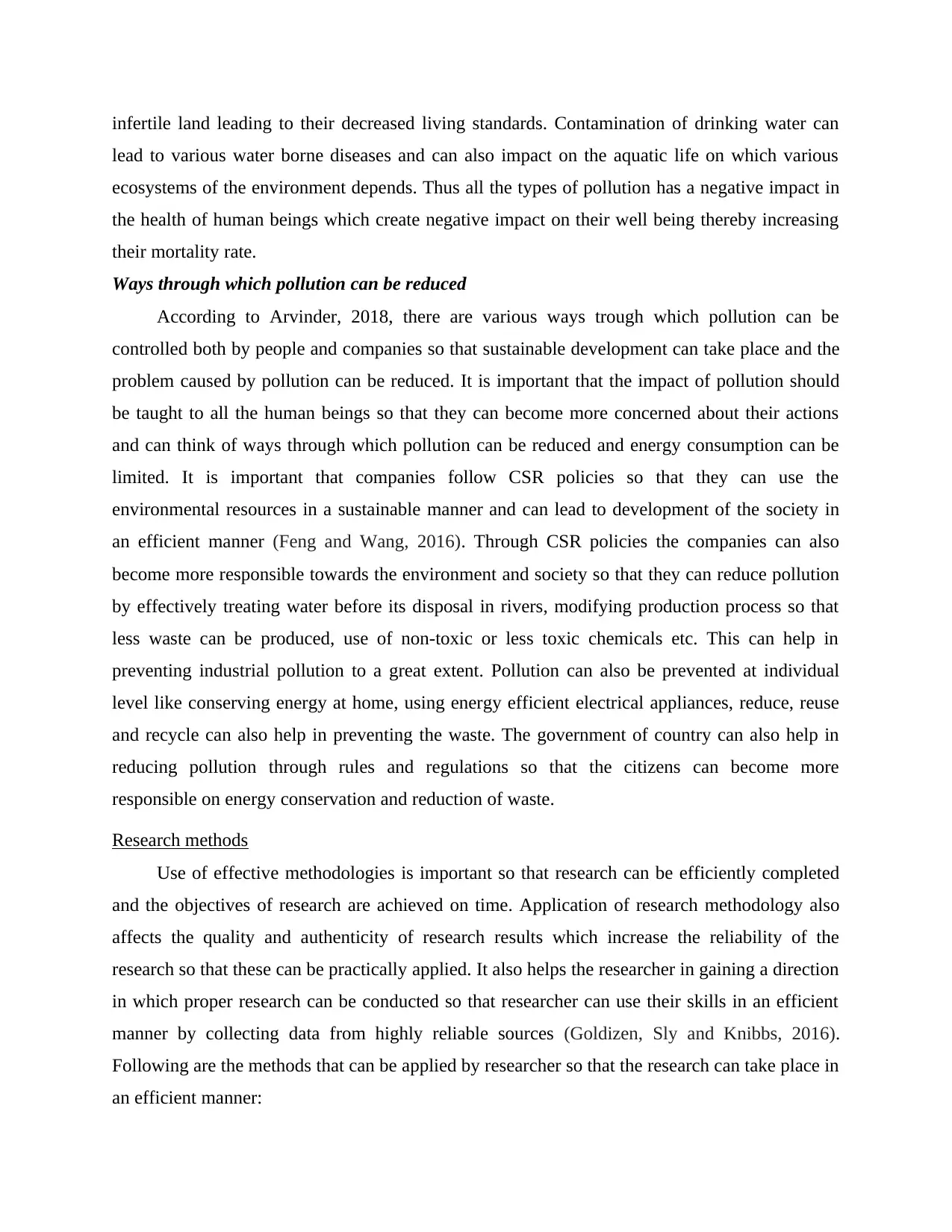
infertile land leading to their decreased living standards. Contamination of drinking water can
lead to various water borne diseases and can also impact on the aquatic life on which various
ecosystems of the environment depends. Thus all the types of pollution has a negative impact in
the health of human beings which create negative impact on their well being thereby increasing
their mortality rate.
Ways through which pollution can be reduced
According to Arvinder, 2018, there are various ways trough which pollution can be
controlled both by people and companies so that sustainable development can take place and the
problem caused by pollution can be reduced. It is important that the impact of pollution should
be taught to all the human beings so that they can become more concerned about their actions
and can think of ways through which pollution can be reduced and energy consumption can be
limited. It is important that companies follow CSR policies so that they can use the
environmental resources in a sustainable manner and can lead to development of the society in
an efficient manner (Feng and Wang, 2016). Through CSR policies the companies can also
become more responsible towards the environment and society so that they can reduce pollution
by effectively treating water before its disposal in rivers, modifying production process so that
less waste can be produced, use of non-toxic or less toxic chemicals etc. This can help in
preventing industrial pollution to a great extent. Pollution can also be prevented at individual
level like conserving energy at home, using energy efficient electrical appliances, reduce, reuse
and recycle can also help in preventing the waste. The government of country can also help in
reducing pollution through rules and regulations so that the citizens can become more
responsible on energy conservation and reduction of waste.
Research methods
Use of effective methodologies is important so that research can be efficiently completed
and the objectives of research are achieved on time. Application of research methodology also
affects the quality and authenticity of research results which increase the reliability of the
research so that these can be practically applied. It also helps the researcher in gaining a direction
in which proper research can be conducted so that researcher can use their skills in an efficient
manner by collecting data from highly reliable sources (Goldizen, Sly and Knibbs, 2016).
Following are the methods that can be applied by researcher so that the research can take place in
an efficient manner:
lead to various water borne diseases and can also impact on the aquatic life on which various
ecosystems of the environment depends. Thus all the types of pollution has a negative impact in
the health of human beings which create negative impact on their well being thereby increasing
their mortality rate.
Ways through which pollution can be reduced
According to Arvinder, 2018, there are various ways trough which pollution can be
controlled both by people and companies so that sustainable development can take place and the
problem caused by pollution can be reduced. It is important that the impact of pollution should
be taught to all the human beings so that they can become more concerned about their actions
and can think of ways through which pollution can be reduced and energy consumption can be
limited. It is important that companies follow CSR policies so that they can use the
environmental resources in a sustainable manner and can lead to development of the society in
an efficient manner (Feng and Wang, 2016). Through CSR policies the companies can also
become more responsible towards the environment and society so that they can reduce pollution
by effectively treating water before its disposal in rivers, modifying production process so that
less waste can be produced, use of non-toxic or less toxic chemicals etc. This can help in
preventing industrial pollution to a great extent. Pollution can also be prevented at individual
level like conserving energy at home, using energy efficient electrical appliances, reduce, reuse
and recycle can also help in preventing the waste. The government of country can also help in
reducing pollution through rules and regulations so that the citizens can become more
responsible on energy conservation and reduction of waste.
Research methods
Use of effective methodologies is important so that research can be efficiently completed
and the objectives of research are achieved on time. Application of research methodology also
affects the quality and authenticity of research results which increase the reliability of the
research so that these can be practically applied. It also helps the researcher in gaining a direction
in which proper research can be conducted so that researcher can use their skills in an efficient
manner by collecting data from highly reliable sources (Goldizen, Sly and Knibbs, 2016).
Following are the methods that can be applied by researcher so that the research can take place in
an efficient manner:
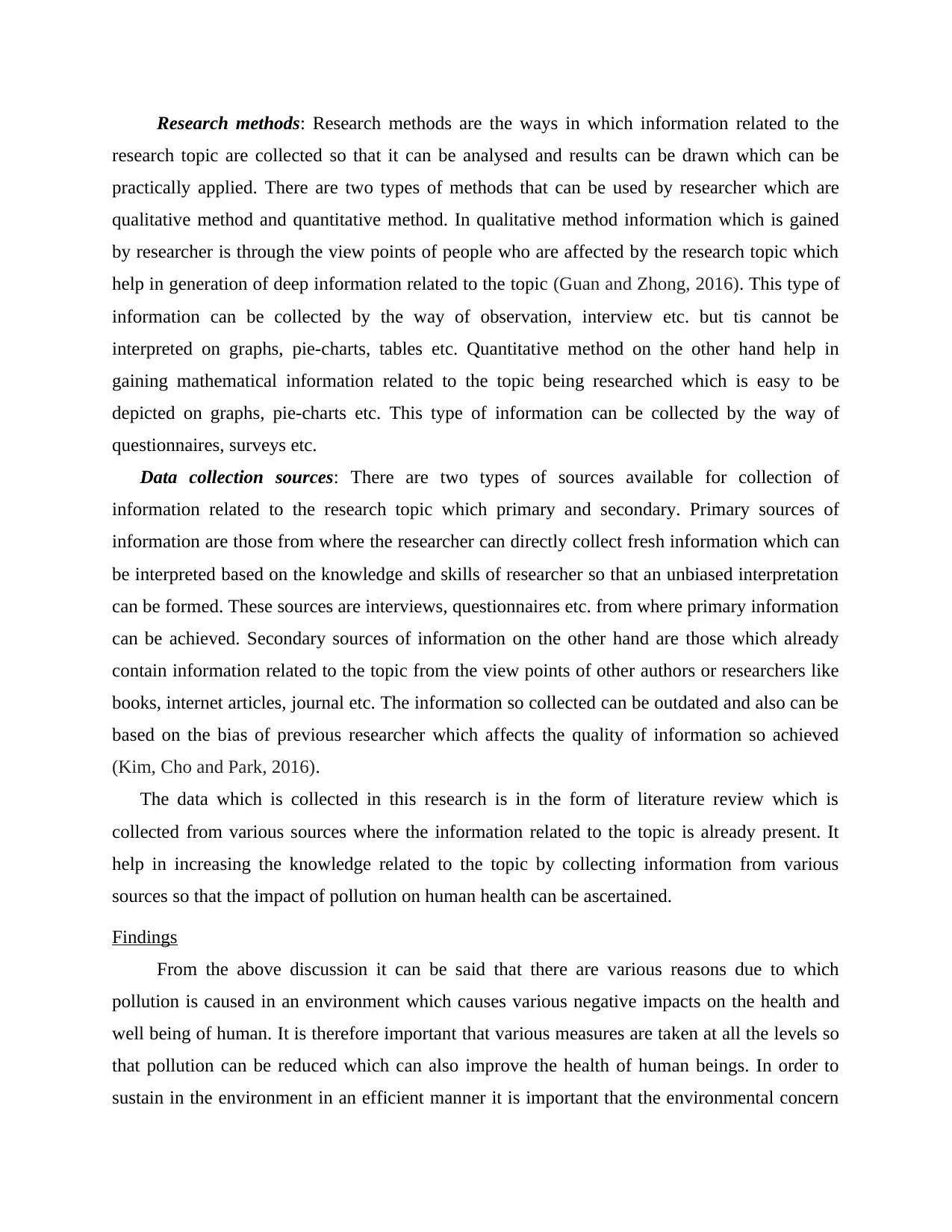
Research methods: Research methods are the ways in which information related to the
research topic are collected so that it can be analysed and results can be drawn which can be
practically applied. There are two types of methods that can be used by researcher which are
qualitative method and quantitative method. In qualitative method information which is gained
by researcher is through the view points of people who are affected by the research topic which
help in generation of deep information related to the topic (Guan and Zhong, 2016). This type of
information can be collected by the way of observation, interview etc. but tis cannot be
interpreted on graphs, pie-charts, tables etc. Quantitative method on the other hand help in
gaining mathematical information related to the topic being researched which is easy to be
depicted on graphs, pie-charts etc. This type of information can be collected by the way of
questionnaires, surveys etc.
Data collection sources: There are two types of sources available for collection of
information related to the research topic which primary and secondary. Primary sources of
information are those from where the researcher can directly collect fresh information which can
be interpreted based on the knowledge and skills of researcher so that an unbiased interpretation
can be formed. These sources are interviews, questionnaires etc. from where primary information
can be achieved. Secondary sources of information on the other hand are those which already
contain information related to the topic from the view points of other authors or researchers like
books, internet articles, journal etc. The information so collected can be outdated and also can be
based on the bias of previous researcher which affects the quality of information so achieved
(Kim, Cho and Park, 2016).
The data which is collected in this research is in the form of literature review which is
collected from various sources where the information related to the topic is already present. It
help in increasing the knowledge related to the topic by collecting information from various
sources so that the impact of pollution on human health can be ascertained.
Findings
From the above discussion it can be said that there are various reasons due to which
pollution is caused in an environment which causes various negative impacts on the health and
well being of human. It is therefore important that various measures are taken at all the levels so
that pollution can be reduced which can also improve the health of human beings. In order to
sustain in the environment in an efficient manner it is important that the environmental concern
research topic are collected so that it can be analysed and results can be drawn which can be
practically applied. There are two types of methods that can be used by researcher which are
qualitative method and quantitative method. In qualitative method information which is gained
by researcher is through the view points of people who are affected by the research topic which
help in generation of deep information related to the topic (Guan and Zhong, 2016). This type of
information can be collected by the way of observation, interview etc. but tis cannot be
interpreted on graphs, pie-charts, tables etc. Quantitative method on the other hand help in
gaining mathematical information related to the topic being researched which is easy to be
depicted on graphs, pie-charts etc. This type of information can be collected by the way of
questionnaires, surveys etc.
Data collection sources: There are two types of sources available for collection of
information related to the research topic which primary and secondary. Primary sources of
information are those from where the researcher can directly collect fresh information which can
be interpreted based on the knowledge and skills of researcher so that an unbiased interpretation
can be formed. These sources are interviews, questionnaires etc. from where primary information
can be achieved. Secondary sources of information on the other hand are those which already
contain information related to the topic from the view points of other authors or researchers like
books, internet articles, journal etc. The information so collected can be outdated and also can be
based on the bias of previous researcher which affects the quality of information so achieved
(Kim, Cho and Park, 2016).
The data which is collected in this research is in the form of literature review which is
collected from various sources where the information related to the topic is already present. It
help in increasing the knowledge related to the topic by collecting information from various
sources so that the impact of pollution on human health can be ascertained.
Findings
From the above discussion it can be said that there are various reasons due to which
pollution is caused in an environment which causes various negative impacts on the health and
well being of human. It is therefore important that various measures are taken at all the levels so
that pollution can be reduced which can also improve the health of human beings. In order to
sustain in the environment in an efficient manner it is important that the environmental concern
⊘ This is a preview!⊘
Do you want full access?
Subscribe today to unlock all pages.

Trusted by 1+ million students worldwide
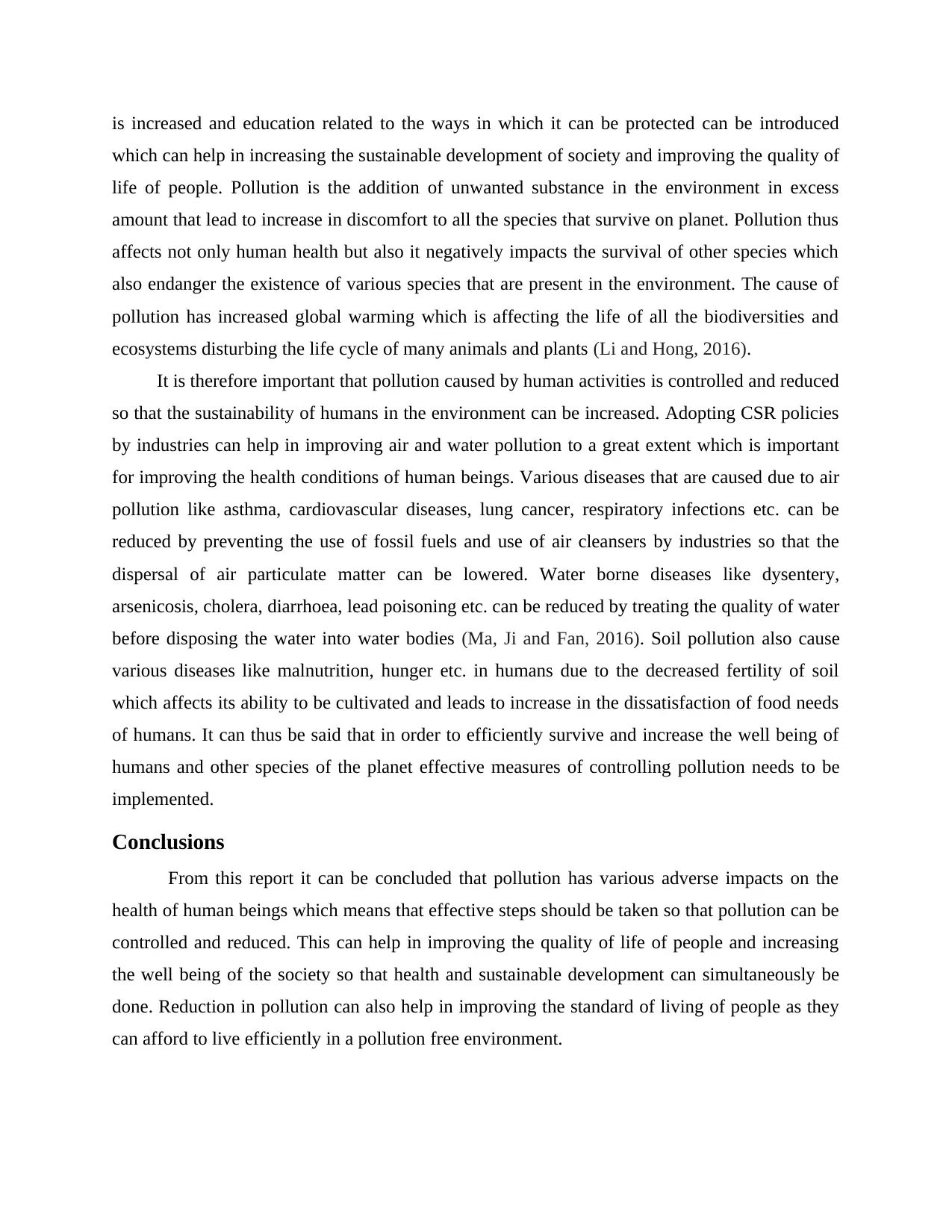
is increased and education related to the ways in which it can be protected can be introduced
which can help in increasing the sustainable development of society and improving the quality of
life of people. Pollution is the addition of unwanted substance in the environment in excess
amount that lead to increase in discomfort to all the species that survive on planet. Pollution thus
affects not only human health but also it negatively impacts the survival of other species which
also endanger the existence of various species that are present in the environment. The cause of
pollution has increased global warming which is affecting the life of all the biodiversities and
ecosystems disturbing the life cycle of many animals and plants (Li and Hong, 2016).
It is therefore important that pollution caused by human activities is controlled and reduced
so that the sustainability of humans in the environment can be increased. Adopting CSR policies
by industries can help in improving air and water pollution to a great extent which is important
for improving the health conditions of human beings. Various diseases that are caused due to air
pollution like asthma, cardiovascular diseases, lung cancer, respiratory infections etc. can be
reduced by preventing the use of fossil fuels and use of air cleansers by industries so that the
dispersal of air particulate matter can be lowered. Water borne diseases like dysentery,
arsenicosis, cholera, diarrhoea, lead poisoning etc. can be reduced by treating the quality of water
before disposing the water into water bodies (Ma, Ji and Fan, 2016). Soil pollution also cause
various diseases like malnutrition, hunger etc. in humans due to the decreased fertility of soil
which affects its ability to be cultivated and leads to increase in the dissatisfaction of food needs
of humans. It can thus be said that in order to efficiently survive and increase the well being of
humans and other species of the planet effective measures of controlling pollution needs to be
implemented.
Conclusions
From this report it can be concluded that pollution has various adverse impacts on the
health of human beings which means that effective steps should be taken so that pollution can be
controlled and reduced. This can help in improving the quality of life of people and increasing
the well being of the society so that health and sustainable development can simultaneously be
done. Reduction in pollution can also help in improving the standard of living of people as they
can afford to live efficiently in a pollution free environment.
which can help in increasing the sustainable development of society and improving the quality of
life of people. Pollution is the addition of unwanted substance in the environment in excess
amount that lead to increase in discomfort to all the species that survive on planet. Pollution thus
affects not only human health but also it negatively impacts the survival of other species which
also endanger the existence of various species that are present in the environment. The cause of
pollution has increased global warming which is affecting the life of all the biodiversities and
ecosystems disturbing the life cycle of many animals and plants (Li and Hong, 2016).
It is therefore important that pollution caused by human activities is controlled and reduced
so that the sustainability of humans in the environment can be increased. Adopting CSR policies
by industries can help in improving air and water pollution to a great extent which is important
for improving the health conditions of human beings. Various diseases that are caused due to air
pollution like asthma, cardiovascular diseases, lung cancer, respiratory infections etc. can be
reduced by preventing the use of fossil fuels and use of air cleansers by industries so that the
dispersal of air particulate matter can be lowered. Water borne diseases like dysentery,
arsenicosis, cholera, diarrhoea, lead poisoning etc. can be reduced by treating the quality of water
before disposing the water into water bodies (Ma, Ji and Fan, 2016). Soil pollution also cause
various diseases like malnutrition, hunger etc. in humans due to the decreased fertility of soil
which affects its ability to be cultivated and leads to increase in the dissatisfaction of food needs
of humans. It can thus be said that in order to efficiently survive and increase the well being of
humans and other species of the planet effective measures of controlling pollution needs to be
implemented.
Conclusions
From this report it can be concluded that pollution has various adverse impacts on the
health of human beings which means that effective steps should be taken so that pollution can be
controlled and reduced. This can help in improving the quality of life of people and increasing
the well being of the society so that health and sustainable development can simultaneously be
done. Reduction in pollution can also help in improving the standard of living of people as they
can afford to live efficiently in a pollution free environment.
Paraphrase This Document
Need a fresh take? Get an instant paraphrase of this document with our AI Paraphraser
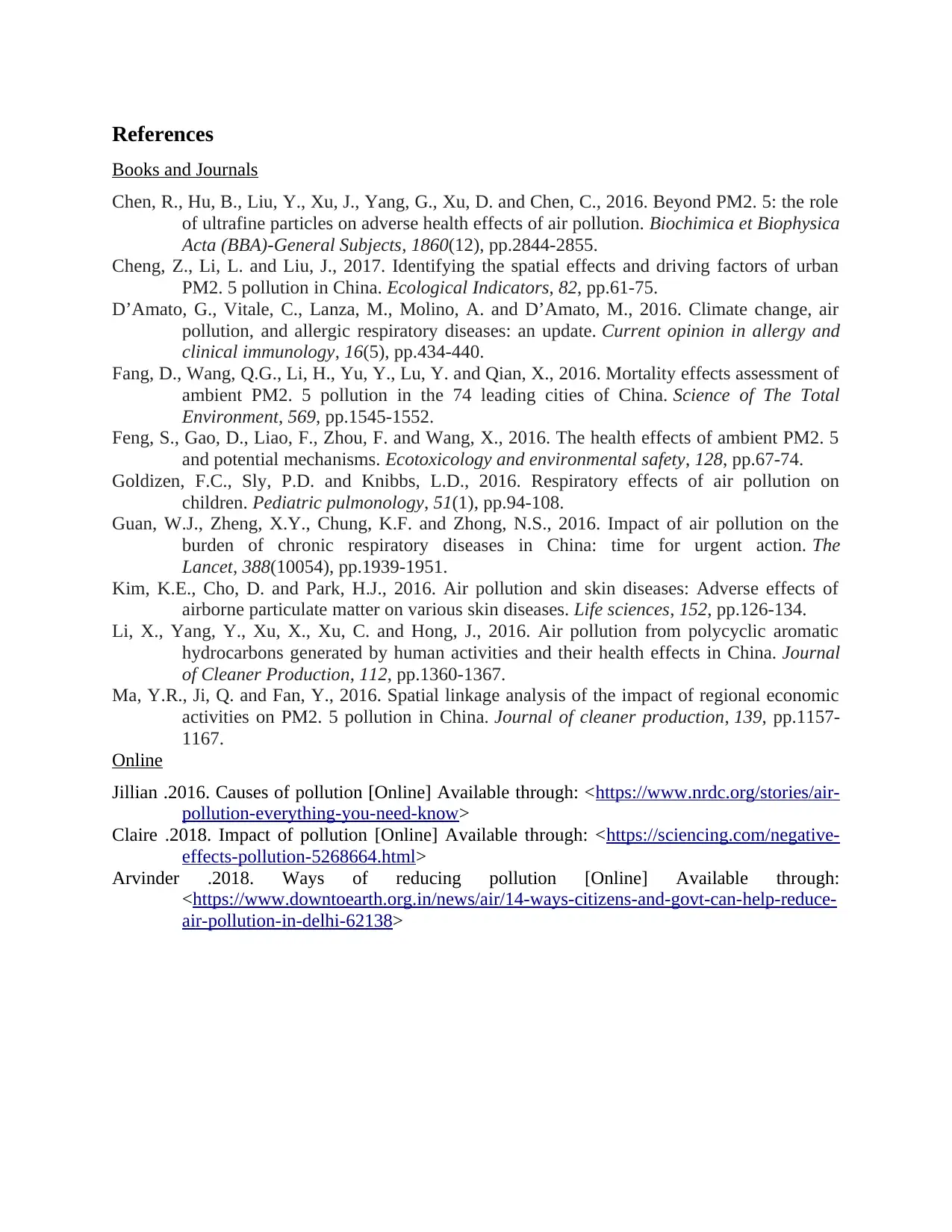
References
Books and Journals
Chen, R., Hu, B., Liu, Y., Xu, J., Yang, G., Xu, D. and Chen, C., 2016. Beyond PM2. 5: the role
of ultrafine particles on adverse health effects of air pollution. Biochimica et Biophysica
Acta (BBA)-General Subjects, 1860(12), pp.2844-2855.
Cheng, Z., Li, L. and Liu, J., 2017. Identifying the spatial effects and driving factors of urban
PM2. 5 pollution in China. Ecological Indicators, 82, pp.61-75.
D’Amato, G., Vitale, C., Lanza, M., Molino, A. and D’Amato, M., 2016. Climate change, air
pollution, and allergic respiratory diseases: an update. Current opinion in allergy and
clinical immunology, 16(5), pp.434-440.
Fang, D., Wang, Q.G., Li, H., Yu, Y., Lu, Y. and Qian, X., 2016. Mortality effects assessment of
ambient PM2. 5 pollution in the 74 leading cities of China. Science of The Total
Environment, 569, pp.1545-1552.
Feng, S., Gao, D., Liao, F., Zhou, F. and Wang, X., 2016. The health effects of ambient PM2. 5
and potential mechanisms. Ecotoxicology and environmental safety, 128, pp.67-74.
Goldizen, F.C., Sly, P.D. and Knibbs, L.D., 2016. Respiratory effects of air pollution on
children. Pediatric pulmonology, 51(1), pp.94-108.
Guan, W.J., Zheng, X.Y., Chung, K.F. and Zhong, N.S., 2016. Impact of air pollution on the
burden of chronic respiratory diseases in China: time for urgent action. The
Lancet, 388(10054), pp.1939-1951.
Kim, K.E., Cho, D. and Park, H.J., 2016. Air pollution and skin diseases: Adverse effects of
airborne particulate matter on various skin diseases. Life sciences, 152, pp.126-134.
Li, X., Yang, Y., Xu, X., Xu, C. and Hong, J., 2016. Air pollution from polycyclic aromatic
hydrocarbons generated by human activities and their health effects in China. Journal
of Cleaner Production, 112, pp.1360-1367.
Ma, Y.R., Ji, Q. and Fan, Y., 2016. Spatial linkage analysis of the impact of regional economic
activities on PM2. 5 pollution in China. Journal of cleaner production, 139, pp.1157-
1167.
Online
Jillian .2016. Causes of pollution [Online] Available through: <https://www.nrdc.org/stories/air-
pollution-everything-you-need-know>
Claire .2018. Impact of pollution [Online] Available through: <https://sciencing.com/negative-
effects-pollution-5268664.html>
Arvinder .2018. Ways of reducing pollution [Online] Available through:
<https://www.downtoearth.org.in/news/air/14-ways-citizens-and-govt-can-help-reduce-
air-pollution-in-delhi-62138>
Books and Journals
Chen, R., Hu, B., Liu, Y., Xu, J., Yang, G., Xu, D. and Chen, C., 2016. Beyond PM2. 5: the role
of ultrafine particles on adverse health effects of air pollution. Biochimica et Biophysica
Acta (BBA)-General Subjects, 1860(12), pp.2844-2855.
Cheng, Z., Li, L. and Liu, J., 2017. Identifying the spatial effects and driving factors of urban
PM2. 5 pollution in China. Ecological Indicators, 82, pp.61-75.
D’Amato, G., Vitale, C., Lanza, M., Molino, A. and D’Amato, M., 2016. Climate change, air
pollution, and allergic respiratory diseases: an update. Current opinion in allergy and
clinical immunology, 16(5), pp.434-440.
Fang, D., Wang, Q.G., Li, H., Yu, Y., Lu, Y. and Qian, X., 2016. Mortality effects assessment of
ambient PM2. 5 pollution in the 74 leading cities of China. Science of The Total
Environment, 569, pp.1545-1552.
Feng, S., Gao, D., Liao, F., Zhou, F. and Wang, X., 2016. The health effects of ambient PM2. 5
and potential mechanisms. Ecotoxicology and environmental safety, 128, pp.67-74.
Goldizen, F.C., Sly, P.D. and Knibbs, L.D., 2016. Respiratory effects of air pollution on
children. Pediatric pulmonology, 51(1), pp.94-108.
Guan, W.J., Zheng, X.Y., Chung, K.F. and Zhong, N.S., 2016. Impact of air pollution on the
burden of chronic respiratory diseases in China: time for urgent action. The
Lancet, 388(10054), pp.1939-1951.
Kim, K.E., Cho, D. and Park, H.J., 2016. Air pollution and skin diseases: Adverse effects of
airborne particulate matter on various skin diseases. Life sciences, 152, pp.126-134.
Li, X., Yang, Y., Xu, X., Xu, C. and Hong, J., 2016. Air pollution from polycyclic aromatic
hydrocarbons generated by human activities and their health effects in China. Journal
of Cleaner Production, 112, pp.1360-1367.
Ma, Y.R., Ji, Q. and Fan, Y., 2016. Spatial linkage analysis of the impact of regional economic
activities on PM2. 5 pollution in China. Journal of cleaner production, 139, pp.1157-
1167.
Online
Jillian .2016. Causes of pollution [Online] Available through: <https://www.nrdc.org/stories/air-
pollution-everything-you-need-know>
Claire .2018. Impact of pollution [Online] Available through: <https://sciencing.com/negative-
effects-pollution-5268664.html>
Arvinder .2018. Ways of reducing pollution [Online] Available through:
<https://www.downtoearth.org.in/news/air/14-ways-citizens-and-govt-can-help-reduce-
air-pollution-in-delhi-62138>
1 out of 8
Related Documents
Your All-in-One AI-Powered Toolkit for Academic Success.
+13062052269
info@desklib.com
Available 24*7 on WhatsApp / Email
![[object Object]](/_next/static/media/star-bottom.7253800d.svg)
Unlock your academic potential
Copyright © 2020–2025 A2Z Services. All Rights Reserved. Developed and managed by ZUCOL.





